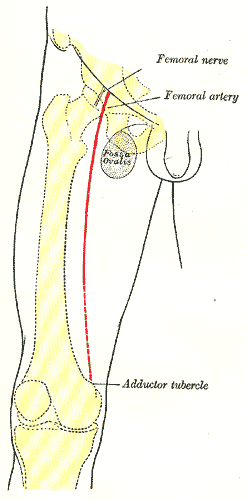Duroziez's sign
Editor-In-Chief: Prab R Tumpati, MD
Obesity, Sleep & Internal medicine
Founder, WikiMD Wellnesspedia &
W8MD medical weight loss NYC and sleep center NYC
| Duroziez's sign | |
|---|---|
| Synonyms | |
| Pronounce | N/A |
| Specialty | Cardiology |
| Symptoms | Murmur heard over the femoral artery |
| Complications | |
| Onset | |
| Duration | |
| Types | |
| Causes | Aortic regurgitation |
| Risks | |
| Diagnosis | Auscultation |
| Differential diagnosis | |
| Prevention | |
| Treatment | |
| Medication | |
| Prognosis | |
| Frequency | |
| Deaths | |
Duroziez's sign is a clinical sign associated with aortic regurgitation. It is characterized by a murmur heard over the femoral artery when it is compressed. This sign is used in the diagnosis of aortic regurgitation and is detected through auscultation. The presence of Duroziez's sign indicates the backflow of blood from the aorta into the left ventricle during diastole.
A clinical sign associated with aortic regurgitation
Duroziez's sign[edit | edit source]
Duroziez's sign is a clinical sign that is indicative of aortic regurgitation. It is named after the French physician Paul Duroziez, who first described it.
Description[edit | edit source]
Duroziez's sign is characterized by a double sound heard over the femoral artery when it is compressed with a stethoscope. This sign is elicited by placing the stethoscope over the femoral artery and applying gentle pressure with the bell of the stethoscope. The double sound, also known as "pistol-shot" sounds, is due to the turbulent flow of blood caused by the regurgitation of blood from the aorta back into the left ventricle during diastole.
Mechanism[edit | edit source]
The mechanism behind Duroziez's sign involves the hemodynamic changes associated with aortic regurgitation. In aortic regurgitation, the aortic valve does not close properly, allowing blood to flow back into the left ventricle during diastole. This results in increased stroke volume and a widened pulse pressure. The turbulent flow of blood in the femoral artery, when compressed, produces the characteristic double sound.
Clinical significance[edit | edit source]
Duroziez's sign is one of several peripheral signs of aortic regurgitation. It is used in conjunction with other clinical findings to diagnose the condition. Other signs include Corrigan's pulse, Quincke's sign, and Traube's sign. The presence of Duroziez's sign can help confirm the diagnosis of aortic regurgitation, especially in the context of other clinical findings.
See Also[edit | edit source]
Search WikiMD
Ad.Tired of being Overweight? Try W8MD's physician weight loss program.
Semaglutide (Ozempic / Wegovy and Tirzepatide (Mounjaro / Zepbound) available.
Advertise on WikiMD
|
WikiMD's Wellness Encyclopedia |
| Let Food Be Thy Medicine Medicine Thy Food - Hippocrates |
Translate this page: - East Asian
中文,
日本,
한국어,
South Asian
हिन्दी,
தமிழ்,
తెలుగు,
Urdu,
ಕನ್ನಡ,
Southeast Asian
Indonesian,
Vietnamese,
Thai,
မြန်မာဘာသာ,
বাংলা
European
español,
Deutsch,
français,
Greek,
português do Brasil,
polski,
română,
русский,
Nederlands,
norsk,
svenska,
suomi,
Italian
Middle Eastern & African
عربى,
Turkish,
Persian,
Hebrew,
Afrikaans,
isiZulu,
Kiswahili,
Other
Bulgarian,
Hungarian,
Czech,
Swedish,
മലയാളം,
मराठी,
ਪੰਜਾਬੀ,
ગુજરાતી,
Portuguese,
Ukrainian
Medical Disclaimer: WikiMD is not a substitute for professional medical advice. The information on WikiMD is provided as an information resource only, may be incorrect, outdated or misleading, and is not to be used or relied on for any diagnostic or treatment purposes. Please consult your health care provider before making any healthcare decisions or for guidance about a specific medical condition. WikiMD expressly disclaims responsibility, and shall have no liability, for any damages, loss, injury, or liability whatsoever suffered as a result of your reliance on the information contained in this site. By visiting this site you agree to the foregoing terms and conditions, which may from time to time be changed or supplemented by WikiMD. If you do not agree to the foregoing terms and conditions, you should not enter or use this site. See full disclaimer.
Credits:Most images are courtesy of Wikimedia commons, and templates, categories Wikipedia, licensed under CC BY SA or similar.
Contributors: Prab R. Tumpati, MD


